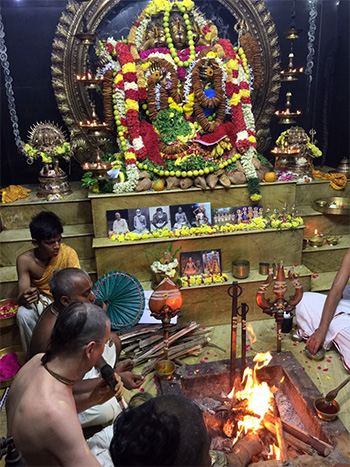Question: I am doing a project on Hinduism and was wondering if you could give me some insight on what hinduism is really about, especially in regards to the concepts of Brahman, Atma, Maya, Karma, and Moksha.
Brahman is the absolute truth. It possesses three spiritual qualities, namely eternality, knowledge, and bliss. Brahman is the cause of all causes, from whom everything comes, by whom everything is maintained, and into whom everything enters after dissolution. Brahman is spiritual, it is situated beyond material qualities and material duality. Some schools of philosophy consider Brahman to be impersonal, others consider Brahman to be the supreme original personality of Godhead.
The Atma refers to the individual living entity as a spirit soul. The atma is one in quality with the Brahman, that is he is of the same spiritual nature, but in quantity he is infinitesimal. It is like a drop of ocean water and the ocean. Though a drop of ocean water may contain the same minerals as the ocean, we cannot consider the drop of ocean water to be the ocean. They are one in quality, different in quantity. There are unlimited individual atmas. Some philosophers consider the individuality of the atma to be eternal, others believe the atma eventually merges back into the Brahman and loses its individuality.
The Brahman is like a fire, and the Atma is like the small sparks that fly out of the fire. Due to their microscopic nature, the small sparks have a tendency to be extinguished. In a similar matter, the infinitesimal atmas have a tendency to be overpowered and covered by illusion, or Maya. The illusion that covers the atma’s true knowledge causes him to falsely identify himself as a product of matter. To accommodate the polluted consciousness of the soul, the nature creates a series of coverings, or koshas, moving from subtle to gross. The congregate of these coverings is what is generally referred to as the body. According to the pollution of the soul’s consciousness he will be given a suitable body, either as a human, animal, plant, or any one of 8,400,000 species of life.
Once embodied, the soul becomes entangled in a chain of actions and reactions, known as Karma. Every moment we are performing thousands of actions, even unknowingly, and these are all creating seeds of reactions which we must later experience either in this life or another. In order to properly receive our due reactions, the nature creates a new suitable body for us to enter at the time of death. Thus we are entrapped in a seemingly endless cycle of actions and reactions.
Only by acting fully in the service of God, offering the fruits of all our actions to God, can we become free from the reactions, or karma. As one engages in the service of God, one’s built up karmic reactions are slowly burnt up, and one becomes free from future bondage. By becoming free from the bondage of our karmas, and by realizing our true nature as a spirit soul (atma) distinct from the body, we remove the coverings of illusion (maya).
When one is free from the illusion of false identification with the body and its possessions, and when one is resituated in his own spiritual form, that state is known as Moksha, or liberation. Some schools of philosophy believe that the atma becomes one with Brahman. Other schools believe the atma is an eternal individual spiritual person, and at the point of moksha he attains the spiritual abode of God, known as Vaikuntha.
The main scriptural book followed by Hindus is the Bhagavad Gita. Other books, such as the Vedas and Upanishads, are mostly only used in rituals. These books are all written in a language called Sanskrit, which is no longer spoken in India. Sanskrit is somewhat similar to Latin in that most the scriptural texts are written in it, but very few people understand it.
Modern western scholars date the age of these Vedic texts to between 1,000 and 3,500 years. In reality these texts are eternal. This Vedic knowledge is present in the ethereal space in all places and spanning all times. The original sound vibration pranava (Om) is the seed of all matter. The recitation of Vedic mantras can be heard in the ether even now through internal meditation. These texts are not authored, but revealed during one’s meditation.
Receive our daily email newsletter on Hinduism, Yoga, Meditation, Ayurveda and Natural Healing.







one of the most simple and complete explanations….ever…
Please accept my dhanyavad,
Hari Om